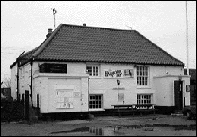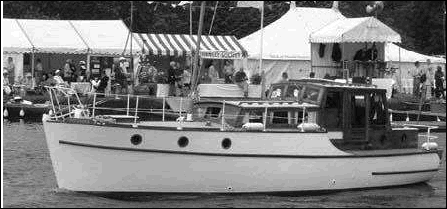| From "The Boater" magazine: | ||
|
The Blissful East Coast |
||
|
Recently
Andrew Scott, family, dog and their 31ft Scottish motor cruiser ‘Thelmarie’ (Built 1949), with only one proper sea trip under
their belt, decided to go adventuring up the East Coast.
|
||
| Provisions stored, final departure checks complete, and with the benefit of light winds and a blue blue sky we set off from Hoo, leaving three hours before high water. Weeks of reading the excellent book East Coast Rivers by Janet Harber had told me that there was a
cunning shortcut avoiding Foulness on the northern side of the huge Thames estuary, provided one was able to cross the Maplin sands before the mud flats dried out, and sneak under the
Havengore bridge. Another book East Coast Rivers from the Air had shown me what to look out for – a modern bridge which was, at least in the photographs, most distinctive.
As we arrived in the area where the bridge was meant to be and with perhaps 30 minutes before we would get stuck on the mud, we learnt that looking out for landmarks on land was a skill which we still needed to acquire. Oh dear! But after a nerve-racking 15-minute search we found it. Crossing under the bridge somehow felt like arriving in a new country, but this was Essex. Our first night was in the rather clinical Burnham Yacht Harbour, an efficient modern marina, but too much of an aquatic car park for us. So off we went the next morning in search of pastures new. The first leg had been calm, and of course it followed that the second leg would be as well. Wrong! Our trip north only some 15 nautical miles over the Dengie Flats was almost as rough as last year’s rough Channel crossing. But our discovering West Mersea on the River Blackwater made it all worth it. West Mersea is one of those special places, with a timeless quality. A single shop, and now a smartish gastro-pub owned by a rather fierce Dutchman, overlooks a creek, crowded with yachts and working fishing boats, and a long all-tide pontoon where one can crab for hours. I could have spent three weeks there, but after a heavenly 24hrs it was time to head north once again. But not before we had a close inspection of an Everyman day cruiser (like ‘Straight Across’ and ‘Brave Molly’), which was half sunk on the mud – a slow painful death for a lovely old lady. As we looked from our tender a hopeful local offered her to us for beer money. But she was all but dead already. ‘Swallows and Amazons’ conjures up the age of innocence, post World War I England, old wooden boats and childhood. So it was with this in mind that we headed north again passing Clacton and Frinton-on-Sea to the Walton Backwaters. It was on the East Coast that Ransome set "We Didn’t Mean to go to Sea". When we got there we opted for the Titchmarch Marina, with all modern facilities, but it turned out to be another ‘boat park’ with a rather nasty but popular restaurant in motorway service station style. There was of course Stone Point, a lovely step-to-shore sand spit, where we swam, had a picnic, and saw seals basking in the sun. The next morning we departed in blazing sun on a glorious trip of some 30 nautical miles passing the rivers Orwell and Deben, all worth visits later, but our destination was one of the most difficult river entrances in Britain; the entrance to the River Ore. The river is entered by the narrowest of shingle bank outlets, almost completely invisible from the sea. What one does is to aim one’s boat straight for the beach at full speed between port and starboard buoys. It felt like surfing, and the boat slewed dreadfully. I remember looking at a man sitting on the beach and I could see the colour of his eyes when it was time to look to starboard – and there was the opening, perhaps 50ft wide, and with an ebb of some 4 knots. The beer in Aldeburgh tasted superb! After a day in Aldeburgh, a most pleasant place, we picked up a buoy off Orford Quay by the delightful Suffolk village of Orford. It has two restaurants, an antique shop, the fascinating Orford Castle (c. 1173) and a harbour-master that my son said looked like Father Christmas, and a 4 knot rip tide. Next stop the Norfolk Broads, where in 1974 my mother had taken us teenagers on boating holidays in nasty plastic things – but here I was, some 30 years on, and instead of a three-hour car trip it felt as if I had gone half-way around the world. The Broads were not the same as I remember them, and very different from the Thames. This was the land of the hire-boat yob where they went as fast as their beer laden boats would go. Amid the yobs there were a few very lovely Broads smacks, with burgundy sails doing their best to ignore the 21st century – but acknowledging us with a polite wave or sunny smile. This was to be the turning point of our trip. Two weeks northbound and one to get back. On the way back we entered the River Blyth by Southwold. With the aid of a slight miscalculation and a late departure from Lowestoft we arrived at the mouth of this aggressive river well into the ebb. The ebb runs south off the Suffolk coast at 3 knots. The river was running at 4.5 knots and there was a strong force five from the south when we arrived. Entering the river was like cruising an arm’s length below Hambleden Weir when the Thames is in severe flood. As we passed between the piers the boat veered and rolled like the worst funfair ride on earth, and our groundspeed can only have been 2 knots, prolonging the punishment. There was a scene reminiscent of the great 50s film Ice Cold in Alex when we got on to the staging in front of the very nice Harbour Inn. Here we spent three days moored up alongside some very interesting Belgian and Dutch boats and two retired school teachers who were circumnavigating Britain. On our way home we visited the River Deben, saying goodbye to all the new friends at the Harbour Inn. I have learnt two things from this trip. Firstly that most of the Essex coast, and all of the Suffolk coast, are very close to heaven, pure paradise – especially in three weeks of glorious English summer sunshine. Secondly I have learnt that with a  practical mind, a seaworthy boat, good preparation, and a sound knowledge of navigation and chart work, there is just so much out there. Four years ago when I bought ‘Thelmarie’, if someone had said that I would take her to Paris and up the East Coast I would have had them certified. practical mind, a seaworthy boat, good preparation, and a sound knowledge of navigation and chart work, there is just so much out there. Four years ago when I bought ‘Thelmarie’, if someone had said that I would take her to Paris and up the East Coast I would have had them certified.The East Coast would take a lifetime to discover properly, but one certainly gets a taste in three weeks – I hope you make the trip one day. We will definitely return again – Harbour Inn (right) here I come ! |
||
| Click to return to The Boater |
